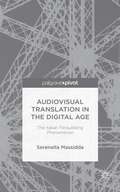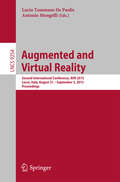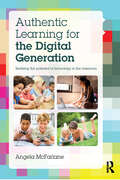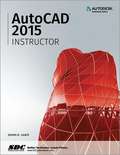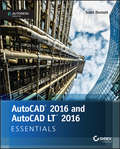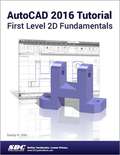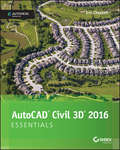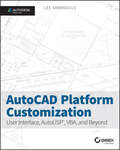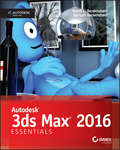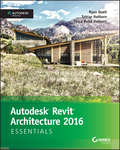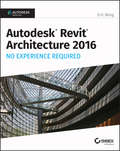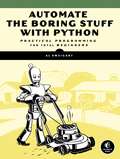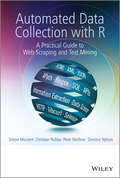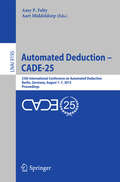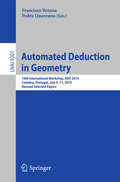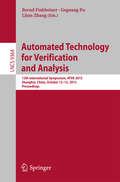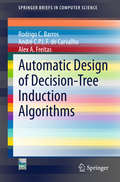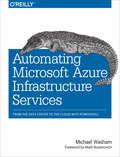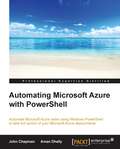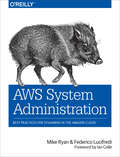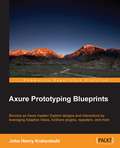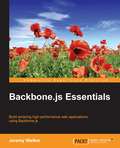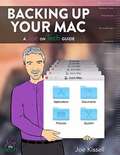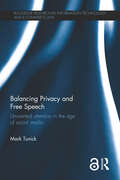- Table View
- List View
Audiovisual Translation in the Digital Age: The Italian Fansubbing Phenomenon
by Serenella MassiddaThis pioneering study on fan translation focuses on Italian fansubbing as a concept, a vibrant cultural and social phenomenon which is described from its inception in 2005 to today. It explores far-reaching issues related to fansubbing and crowdsourcing, highlighting in particular the benefits and drawbacks of Web 2. 0.
Augmented and Virtual Reality: Second International Conference, AVR 2015, Lecce, Italy, August 31 - September 3, 2015, Proceedings (Lecture Notes in Computer Science #9254)
by Lucio Tommaso De Paolis Antonio MongelliThis book constitutes the refereed proceedings of the Second International Conference on Augmented and Virtual Reality, AVR 2015, held in Lecce, Italy, in September 2015. The 32 papers and 8 short papers presented were carefully reviewed and selected from 82 submissions. The SALENTO AVR 2015 conference brings together a community of researchers from academia and industry, computer scientists, engineers, and physicians in order to share points of views, knowledge, experiences, and scientific and technical results related to state-of-the-art solutions and technologies on virtual and augmented reality applications for medicine, cultural heritage, education, industrial sectors, as well as the demonstration of advanced products and technologies.
Authentic Learning for the Digital Generation: Realising the potential of technology in the classroom
by Angela McFarlaneWhy should we use technology to support learning? Where does the responsibility lie to prepare young people to be active and successful cybercitizens? Can we go on confiscating pupils’ smartphones indefinitely? Authentic Learning for the Digital Generation is a vital examination of young people’s use of personal devices, online creative communities and digital gaming. It calls into question the idea of the ‘digital native’ and shows clearly that the majority of young users need help and support in order to benefit from the rich learning potential of personal, mobile and online technology use. Written by a leading authority on the role of digital technologies in education, it looks in detail at the practice and implications of learning using personal devices, collaborative online spaces, learning platforms, user generated content and digital games. In particular, approaches to solving problems, building knowledge, manipulating data and creating texts are examined. It offers clear strategies, a vision for what effects on learning we might reasonably expect when children are given access to different types of technology, and explores the challenges of managing these practices in the classroom. Authentic Learning for the Digital Generation offers careful analysis at a time when there is much discussion about young people emerging from school unprepared for the world of work and often struggling to manage their personal relationships as they are exposed to strong content and harsh criticism online. It considers what we know of childhood experience in a digital world and offers ways in which schools and teachers can embrace the opportunity presented by ubiquitous ownership of connected, digital devices to enrich and deepen learning.
AutoCAD 2015 Instructor: A Student Guide for In-Depth Coverage of AutoCAD's Commands and Features
by James A. LeachThe objective of AutoCAD 2015 Instructor is to provide you with extensive knowledge of AutoCAD, whether you are taking an instructor-led course or learning AutoCAD on your own. In-Depth Coverage AutoCAD 2015 Instructor is written to instruct you in a broad and deep range of AutoCAD 2015 features. Commands, options, system variables, and features are explained fully with many examples and illustrations. This text can be used for a two or three course sequence.
AutoCAD 2016 and AutoCAD LT 2016 Essentials: Autodesk Official Press
by Scott OnstottLearn AutoCAD 2016 quickly and painlessly with this practical hands-on guide AutoCAD 2016 Essentials gets you up to speed quickly, with hands-on instruction on the program's core features and functions. This new edition provides more manufacturing and landscape examples, a stronger emphasis on skills rather than tools, starting and ending files for every exercise, and a more clearly defined layout that separates the step-by-step instructions from the "why" discussion. Based on the real-world task of designing a house, the hands-on exercises help you quickly develop confidence and become productive with the software as you master the major 2D functions and move into 3D modeling. From layout to presentation, this in-depth guide takes you through the entire design process, and provides downloadable data so you can compare your work to the pros. If you're preparing for AutoCAD certification, this book is the ideal study guide — and the only one officially endorsed by Autodesk. This book is your unique learning resource that features concise, straightforward explanations and hands-on exercises. Each chapter opens with a quick discussion of concepts, and then briskly moves into an approachable, practical tutorial that helps you gain confidence in your new AutoCAD 2016 skills. Master the AutoCAD interface and basic 2D drawing skills Work with splines, polylines, hatch patterns, and gradients Organize objects with layers, groups, blocks, and cross-referencing Use constraints and layouts, print and export, model in 3D, and much more If you're a design professional, AutoCAD is need-to-know software. You have to be comfortable with it to be productive. AutoCAD 2016 Essentials gets you up and running quickly, with patient instruction and plenty of hands-on practice.
AutoCAD 2016 Tutorial First Level 2D Fundamentals
by Randy ShihThe primary goal of AutoCAD 2016 Tutorial First Level 2D Fundamentals is to introduce the aspects of Computer Aided Design and Drafting (CADD). This text is intended to be used as a training guide for students and professionals. This text covers AutoCAD 2016 and the lessons proceed in a pedagogical fashion to guide you from constructing basic shapes to making multiview drawings. This textbook contains a series of eleven tutorial style lessons designed to introduce beginning CAD users to AutoCAD 2016. It takes a hands-on, exercise-intensive approach to all the important 2D CAD techniques and concepts. This text is also helpful to AutoCAD users upgrading from a previous release of the software. The new improvements and key enhancements of the software are incorporated into the lessons.
AutoCAD Civil 3D 2016 Essentials: Autodesk Official Press
by Eric ChappellStart designing today with this hands-on beginner's guide to AutoCAD Civil 3D 2016 AutoCAD Civil 3D 2016 Essentials gets you quickly up to speed with the features and functions of this industry-leading civil engineering software. This full-color guide features approachable, hands-on exercises and additional task-based tutorials that help you quickly become productive as you master the fundamental aspects of AutoCAD Civil 3D design. Each chapter opens with a quick discussion of concepts and learning goals, and then briskly moves into tutorial mode with screen shots that illustrate each step of the process. The emphasis is on skills rather than tools, and the clear delineation between "why" and "how" makes this guide ideal for quick reference. The companion website provides starting and ending files for each exercise, so you can jump in at any point and compare your work with the pros. Centered around the real-world task of designing a residential subdivision, these exercises get you up to speed with the program's functionality, while also providing the only Autodesk-endorsed preparation for the AutoCAD Civil 3D certification exam. Master the AutoCAD Civil 3D 2016 interface and basic tasks Model terrain using imported field survey data Analyze boundaries, pipe networks, surfaces, and terrain Estimate quantities and create construction documentation If you're ready to acquire this must-have skillset, AutoCAD Civil 3D 2016 Essentials will get you up to speed quickly and easily.
AutoCAD Platform Customization: User Interface, AutoLISP, VBA, and Beyond
by Lee AmbrosiusTake control of AutoCAD for a more efficient, streamlined workflow AutoCAD Platform Customization is the most comprehensive guide to streamlining and personalizing the AutoCAD platform. The AutoLISP and VBA programming languages open up a myriad of customization options, and this book provides expert guidance toward applying them to AutoCAD, Civil 3D, Plant 3D, and other programs based on the Autodesk AutoCAD platform. Detailed discussions backed by real-world examples and step-by-step tutorials provide user-friendly instruction, and downloadable datasets allow for hands-on learning. Through customization you can increase screen real estate, streamline workflows, and create more accurate drawings by unleashing powerful programming languages that allow the user to command the software how to work, instead of the other way around. AutoCAD customization is commonly performed by system administrators and CAD managers, but senior drafters and savvy users are increasingly taking customization into their own hands. AutoLISP and VBA are two popular and versatile tools that allow for going beyond the boundaries of normal user interface customization options, allowing users to: Enforce drawing and CAD standards, and automate repetitive tasks Customize the workspace, including tool sets, ribbon tabs and panels, and palettes Modify graphical objects, set system variables, integrate with external software, and more Manage blocks, change the interface, create dialog boxes, and communicate with Microsoft Office applications The ideal design environment puts the tools you need right at your fingertips, removes unnecessary steps, and fosters precision through good communication. Customizing, including applying AutoLISP and VBA to AutoCAD, enables all of this and much more. For the designer who needs to work smarter because it's impossible to work any harder, AutoCAD Platform Customization provides the key information, insight, and techniques that will help to increase your productivity with AutoCAD.
Autodesk 3ds Max 2016 Essentials
by Dariush Derakhshani Randi L. DerakhshaniStart animating right away with this tutorial-based guide to Autodesk 3ds Max 2016 Autodesk 3ds Max 2016 Essentials is your perfect hands-on guide to start animating quickly. Using approachable, real-world exercises, you'll master the fundamentals of this leading animation software by following full-color screen shots step by step. Each chapter opens with a quick discussion of concepts and learning objectives, and then launches into hands-on tutorials that give you firsthand experience and a good start on preparing for the 3ds Max certification exam. You'll learn the basics of modeling, texturing, animating, and visual effects as you create a retro-style alarm clock, animate a thrown knife, model a chair, and more. Whether you're a complete beginner or migrating from another 3D application, this task-based book provides the solid grounding you need in Autodesk 3ds Max 2016. Model your character with polygons, meshes, and more Add motion with simple and complex animations Add color and textures to visualize materials and surfaces Render interior scenes with great lighting and camera placement If you want to learn 3ds Max quickly and painlessly, Autodesk 3ds Max 2016 Essentials helps you start animating today.
Autodesk Revit Architecture 2016 Essentials: Autodesk Official Press
by Ryan Duell Tobias Hathorn Tessa Reist HathornPut Autodesk Revit Architecture 2016 to work for you with this real-world focused guide Autodesk Revit Architecture 2016 Essentials helps you get acquainted and quickly become productive with the leading Building Information Modeling software. With a real-world focus and a tutorial-based approach, this invaluable guide features concise, straightforward explanations and hands-on exercises that walk you through the entire design process. Each chapter opens with a quick discussion of concepts and learning goals, and then briskly moves into step-by-step instruction illustrated by compelling full-color screen shots. This new edition includes expanded information on rendering and visualization, and a new discussion surrounding effective work sharing, details and annotations, drawing sets, and professional workflows. The companion website features additional tutorials, plus downloadable data sets that allow you to jump in at any point and compare your work to the pros. Revit Architecture 2016 is a powerful, sophisticated BIM application designed to boost productivity with automated documentation for every design and update. This guide takes you through the entire design process, and shows you how to get the most out of Revit every step of the way. Design walls, floors, roofs, ceilings, stairs, ramps, railings, and more Work with families, groups, and phasing, and add color fills and rendering Create compelling drawing sets with details and annotations Learn the tips and tricks experts use to get the most out of Revit Autodesk Revit Architecture 2016 Essentials gets you up to speed quickly, so you can win more bids and expedite the project approval process.
Autodesk Revit Architecture 2016 No Experience Required: Autodesk Official Press
by Eric WingGo from beginner to guru quickly with the ultimate Revit Architecture 2016 guide Autodesk Revit Architecture 2016 No Experience Required is your ultimate hands-on guide for mastering this essential BIM software. With step-by-step instruction and a continuous tutorial approach, this invaluable guide walks you through the design of a four-story office building. You'll be led through the entire design, documentation, and presentation process with expert instruction and helpful tips, so you can quickly become confident and productive. You'll follow a real-world workflow as you jump right into modeling, first placing doors and windows, then building floors layer-by-layer, adding roofs and ceilings, stairs, ramps, and railings. Coverage includes crucial information on detailing, view and match line information, and printing, plus advanced topics like curtain walls, sweeps, embedded families, and formulas. You'll delve into site considerations including grading and topsurface features, and integrate them into your design at the rendering stage. The companion website provides downloadable tutorial files so you can jump in at any point and compare your work to the pros. Revit is the industry-leading Building Information Management software, hailed for its power and sophistication. This guide helps you get the most out of the software, with expert instruction and plenty of practice. Master the interface, tools, views, and editing capabilities Work with structural objects, text, dimensions, and multi-story buildings Generate construction documentation, schedules, and material takeoffs Explore phase management, work sharing, and working with various formats BIM is the emerging paradigm for architects and others in the construction and engineering fields. Revit is the industry leader, and is quickly becoming a mandatory skillset. Autodesk Revit Architecture 2016 No Experience Required provides everything you need to get up to speed and down to work.
Automate the Boring Stuff with Python: Practical Programming for Total Beginners
by Al SweigartIf you’ve ever spent hours renaming files or updating hundreds of spreadsheet cells, you know how tedious tasks like these can be. But what if you could have your computer do them for you?In Automate the Boring Stuff with Python, you’ll learn how to use Python to write programs that do in minutes what would take you hours to do by hand—no prior programming experience required. Once you’ve mastered the basics of programming, you’ll create Python programs that effortlessly perform useful and impressive feats of automation to:–Search for text in a file or across multiple files–Create, update, move, and rename files and folders–Search the Web and download online content–Update and format data in Excel spreadsheets of any size–Split, merge, watermark, and encrypt PDFs–Send reminder emails and text notifications–Fill out online formsStep-by-step instructions walk you through each program, and practice projects at the end of each chapter challenge you to improve those programs and use your newfound skills to automate similar tasks.Don’t spend your time doing work a well-trained monkey could do. Even if you’ve never written a line of code, you can make your computer do the grunt work. Learn how in Automate the Boring Stuff with Python.Note: The programs in this book are written to run on Python 3.
Automated Data Collection with R: A Practical Guide to Web Scraping and Text Mining
by Simon Munzert Christian Rubba Peter Meißner Dominic NyhuisA hands on guide to web scraping and text mining for both beginners and experienced users of R Introduces fundamental concepts of the main architecture of the web and databases and covers HTTP, HTML, XML, JSON, SQL. Provides basic techniques to query web documents and data sets (XPath and regular expressions). An extensive set of exercises are presented to guide the reader through each technique. Explores both supervised and unsupervised techniques as well as advanced techniques such as data scraping and text management. Case studies are featured throughout along with examples for each technique presented. R code and solutions to exercises featured in the book are provided on a supporting website.
Automated Deduction - CADE-25: 25th International Conference on Automated Deduction, Berlin, Germany, August 1-7, 2015, Proceedings (Lecture Notes in Computer Science #9195)
by Amy P. Felty Aart MiddeldorpThis book constitutes the proceedings of the 25th International Conference on Automated Deduction, CADE-25, held in Berlin, Germany, in August 2015. The 36 revised full papers presented ( 24 full papers and 12 system descriptions) were carefully reviewed and selected from 85 submissions. CADE is the major forum for the presentation of research in all aspects of automated deduction, including foundations, applications, implementations and practical experience.
Automated Deduction in Geometry: 10th International Workshop, ADG 2014, Coimbra, Portugal, July 9-11, 2014, Revised Selected Papers (Lecture Notes in Computer Science #9201)
by Francisco Botana Pedro QuaresmaThis book constitutes the thoroughly refereed post-workshop proceedings of the 10th International Workshop on Automated Deduction in Geometry, ADG 2014, held in Coimbra, Portugal, in July 2014. The 11 revised full papers presented in this volume were carefully selected from 20 submissions. The papers show the trend set of current research in automated reasoning in geometry.
Automated Technology for Verification and Analysis: 13th International Symposium, ATVA 2015, Shanghai, China, October 12-15, 2015, Proceedings (Lecture Notes in Computer Science #9364)
by Bernd Finkbeiner Geguang Pu Lijun ZhangThis book constitutes the proceedings of the 13th International Symposium on Automated Technology for Verification and Analysis, ATVA 2015, held in Shanghai, China, in October 2015. The 27 revised papers presented together with 6 tool papers in this volume were carefully reviewed and selected from 95 submissions. They show current research on theoretical and practical aspects of automated analysis, verification and synthesis by providing an international forum for interaction among the researchers in academia and industry.
Automatic Design of Decision-Tree Induction Algorithms (SpringerBriefs in Computer Science)
by Rodrigo C. Barros André C.P.L.F de Carvalho Alex A. FreitasPresents a detailed study of the major design components that constitute a top-down decision-tree induction algorithm, including aspects such as split criteria, stopping criteria, pruning and the approaches for dealing with missing values. Whereas the strategy still employed nowadays is to use a 'generic' decision-tree induction algorithm regardless of the data, the authors argue on the benefits that a bias-fitting strategy could bring to decision-tree induction, in which the ultimate goal is the automatic generation of a decision-tree induction algorithm tailored to the application domain of interest. For such, they discuss how one can effectively discover the most suitable set of components of decision-tree induction algorithms to deal with a wide variety of applications through the paradigm of evolutionary computation, following the emergence of a novel field called hyper-heuristics. "Automatic Design of Decision-Tree Induction Algorithms" would be highly useful for machine learning and evolutionary computation students and researchers alike.
Automating Microsoft Azure Infrastructure Services
by Michael WashamGet valuable tips and techniques for automating your cloud deployments with Azure PowerShell cmdlets, and learn how to provision Azure services on the fly. In this hands-on guide, Microsoft cloud technology expert Michael Washam shows you how to automate various management tasks and deploy solutions that are both complex and at scale.By combining the native automation capabilities of PowerShell with Azure Infrastructure Services, these powerful cmdlets enable you to create and configure virtual machines with ease. You'll learn how to take advantage of these technologies to build complete virtual networks. If you have experience with PowerShell and Azure, you're ready to get started.Install and authenticate cmdlets to set up your environmentCreate and update virtual machines with Azure platform imagesManage network endpoints, access control lists, and IP addressesUse cmdlets to manage and configure virtual machine storageAutomate Azure virtual networks with hybrid technologies such as site-to-site, point-to-site, and ExpressRouteDive into advanced virtual machine provisioning capabilities and management techniquesLearn tips and tricks for deleting or moving virtual machines within (or out of) your subscription
Automating Microsoft Azure with PowerShell
by Aman Dhally John ChapmanThis book is designed to help administrators and developers better automate Azure management tasks. No prior knowledge of PowerShell is required.
AWS System Administration: Best Practices for Sysadmins in the Amazon Cloud
by Mike Ryan Federico LucifrediWith platforms designed for rapid adaptation and failure recovery such as Amazon Web Services, cloud computing is more like programming than traditional system administration. Tools for automatic scaling and instance replacement allow even small DevOps teams to manage massively scalable application infrastructures—if team members drop their old views of development and operations and start mastering automation.This comprehensive guide shows developers and system administrators how to configure and manage AWS services including EC2, CloudFormation, Elastic Load Balancing, S3, and Route 53. Sysadms will learn will learn to automate their favorite tools and processes; developers will pick up enough ops knowledge to build a robust and resilient AWS application infrastructure.Launch instances with EC2 or CloudFormationSecurely deploy and manage your applications with AWS toolsLearn to automate AWS configuration management with Python and PuppetDeploy applications with Auto Scaling and Elastic Load BalancingExplore approaches for deploying application and infrastructure updatesSave time on development and operations with reusable componentsLearn strategies for managing log files in AWS environmentsConfigure a cloud-aware DNS service with Route 53Use AWS CloudWatch to monitor your infrastructure and applications
Axure Prototyping Blueprints
by John Henry KrahenbuhlIf you are a user, experienced professional, designer, information architect, or business analyst who wants to explore common design patterns and enhance your interactive prototyping skills with Axure, then this book is ideal for you.
Backbone.js Essentials
by Jeremy WalkerIf you are a developer with baseline JavaScript proficiency and are familiar with the jQuery library, then this book is ideal for you. Whether you've tried building complex web applications before and been frustrated by the challenge of doing so without the proper tools, or whether you've only built simple websites and are now looking to create full-featured web applications, this book has everything you need to get ahead of the curve.
Backing Up Your Mac
by Joe KissellThe Definitive Guide to Mac Backups <P><P> Your Mac contains valuable and sometimes irreplaceable files--family photos and videos, business documents, your unfinished novel... not to mention personal data such as email, contacts, and calendars. Without great backups, all of that data could disappear in an instant. We don't like to think about theft, fire, and natural disasters, but these things happen. So do hard drive crashes and other malfunctions (not to mention user error). <P> Your best insurance against losing data forever is a thorough, carefully designed backup plan. You don't have to spend a ton of money or be a technical whiz to back up your Mac. This book helps you design a sensible backup strategy, choose and configure the best backup hardware and software for your needs, and understand how to make your backups as painless as possible. <P> * Learn Joe's simple, three-prong strategy for bulletproof Mac backups. <P> * Decide whether Time Machine is right for you--and if so, learn how to use it for backing up and restoring data. <P> * Discover alternatives to Time Machine for storing multiple versions of your files. <P> * Find out why and how to create a bootable duplicate (or clone) of your Mac's startup volume. <P> * Choose the best hardware for backing up your data. <P> * Learn about offsite storage, including cloud backup services. <P> * Know exactly what you'll need to do if disaster strikes. <P> * Deal with special backup needs, such as large video files, backups while on the road, and backing up a small network.
Backing Up Your Mac
by Joe KissellThe data on every Mac should be backed up to protect against theft, hardware failure, user error, and other catastrophes. This book helps you design a sensible backup strategy, choose and configure the best backup hardware and software for your needs, and understand how to make your backups as painless as possible.
Balancing Privacy and Free Speech: Unwanted Attention in the Age of Social Media (Routledge Research in Information Technology and E-Commerce Law)
by Mark TunickIn an age of smartphones, Facebook and YouTube, privacy may seem to be a norm of the past. This book addresses ethical and legal questions that arise when media technologies are used to give individuals unwanted attention. Drawing from a broad range of cases within the US, UK, Australia, Europe, and elsewhere, Mark Tunick asks whether privacy interests can ever be weightier than society’s interest in free speech and access to information. Taking a comparative and interdisciplinary approach, and drawing on the work of political theorist Jeremy Waldron concerning toleration, the book argues that we can still have a legitimate interest in controlling the extent to which information about us is disseminated. The book begins by exploring why privacy and free speech are valuable, before developing a framework for weighing these conflicting values. By taking up key cases in the US and Europe, and the debate about a ‘right to be forgotten’, Tunick discusses the potential costs of limiting free speech, and points to legal remedies and other ways to develop new social attitudes to privacy in an age of instant information sharing. This book will be of great interest to students of privacy law, legal ethics, internet governance and media law in general.
